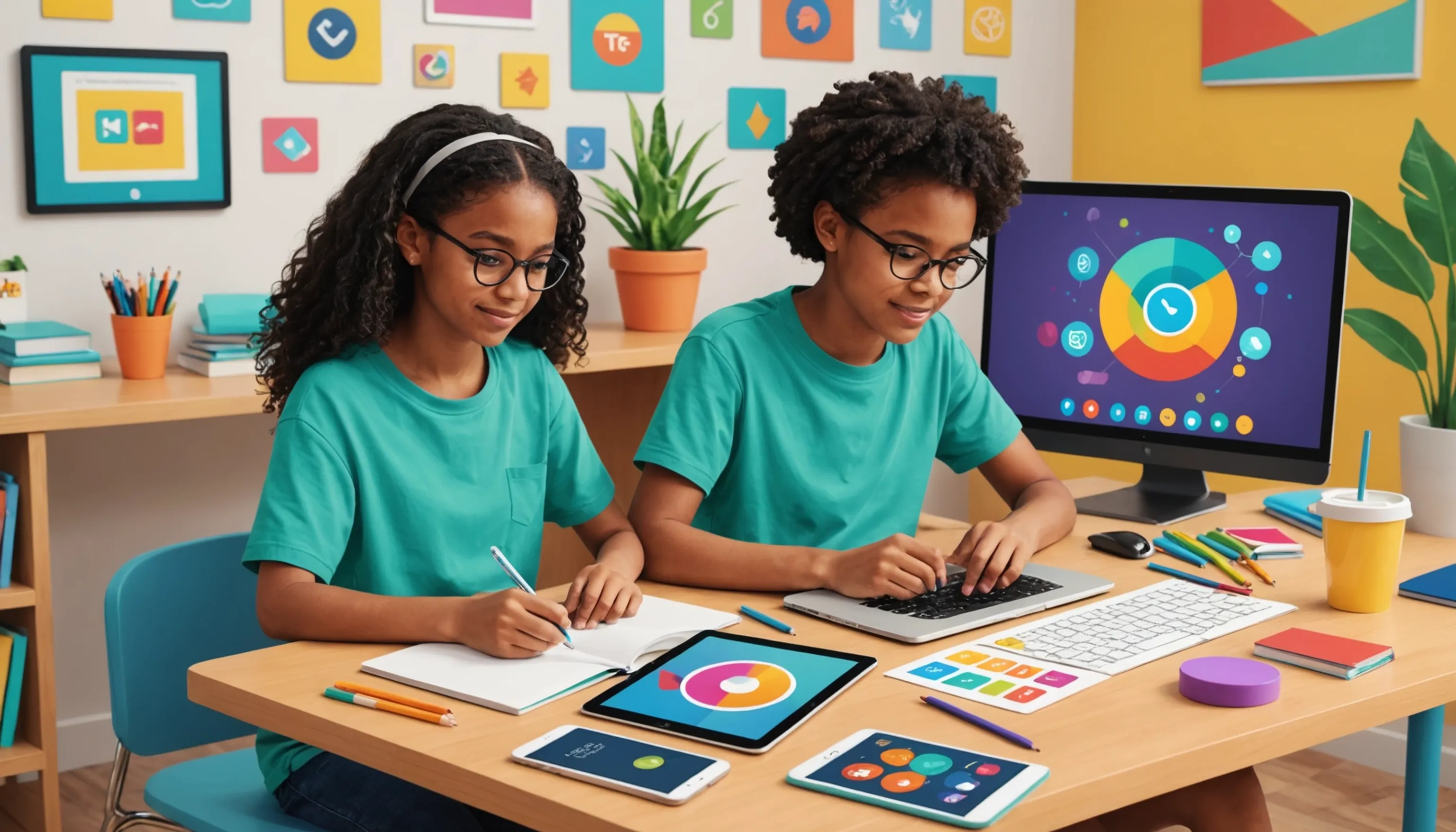Understanding Useful Screentime for Teenagers
 HvWHenry van Wagenberg
HvWHenry van Wagenberg
Understanding Useful Screentime for Teenagers
Understanding useful screentime for teenagers is essential in today’s digital age. Screentime encompasses the hours spent on devices, but not all of it is detrimental. Useful screentime refers to activities that promote learning, creativity, and social interaction.
For instance, educational apps, online courses, and virtual collaborations can enhance a teen's skills. Meanwhile, connecting with friends through video calls or gaming can strengthen social bonds. It's crucial for parents and teachers to recognize the difference between passive scrolling and engaging activities, ensuring that screentime contributes positively to a teenager's development.
What is Screentime and Its Importance?
Screentime refers to the time spent in front of screens, including TVs, computers, tablets, and smartphones. In today's tech-driven world, understanding screentime is crucial for parents and educators, especially concerning teenagers. It encompasses both productive and unproductive activities, making its evaluation essential.
The importance of screentime lies in its impact on various aspects of a teen’s life. On one hand, excessive screentime can lead to negative outcomes such as decreased physical activity, disrupted sleep patterns, and increased risk of mental health issues. On the other hand, when managed correctly, screentime can be a valuable tool for learning and socialization.
For teenagers, useful screentime can include:
- Educational content: Online courses and tutorials that enhance academic skills.
- Creative pursuits: Digital art, music production, or coding that foster creativity.
- Social interaction: Connecting with peers through gaming or social media that build friendships.
Balancing screentime is essential for maximizing its benefits while minimizing potential harm. By distinguishing between productive and unproductive screentime, parents can help guide teens in making positive choices. This approach encourages a healthy relationship with technology, ensuring that screentime contributes to personal growth and development rather than detracting from it.

Types of Useful Screentime Activities
There are various types of useful screentime activities that can benefit teenagers. These activities not only promote learning but also help develop essential life skills. Here are some popular categories:
- Educational Apps: Numerous applications focus on subjects like math, science, and language arts. Apps such as Khan Academy and Duolingo provide interactive learning experiences that can supplement school education.
- Online Courses: Websites like Coursera and Udemy offer courses on diverse topics ranging from coding to photography. These platforms allow teenagers to explore new interests and gain valuable skills at their own pace.
- Creative Projects: Encouraging teens to engage in creative pursuits like digital art, video editing, or music production can be incredibly rewarding. Tools such as Adobe Spark or GarageBand enable them to express their creativity while developing technical skills.
- Virtual Collaboration: Participating in group projects through platforms like Google Docs or Zoom fosters teamwork and communication skills. Teens can collaborate with peers on assignments, enhancing their ability to work in a team setting.
- Physical Activity: Fitness apps and online workout videos can motivate teens to stay active. Platforms like YouTube have countless resources for dance, yoga, and other exercise routines.
By encouraging these types of activities, parents and educators can help teenagers make the most of their screentime, ensuring it is both productive and enriching.
How to Balance Screentime for Teens
Balancing screentime for teens is crucial for their overall well-being. Start by setting clear daily limits on screentime, ensuring it doesn’t interfere with sleep, homework, or family time. Encourage a mix of activities by designating specific times for educational and recreational screentime.
Additionally, promote screen-free activities such as outdoor sports, reading, or hobbies that stimulate creativity. Regularly review and adjust screentime rules based on your teen’s needs and responsibilities. Engaging in conversations about their screentime choices helps foster understanding, ensuring they use technology in a way that benefits their development.

Setting Healthy Screentime Limits
Setting healthy screentime limits is essential for maintaining a balanced lifestyle for teenagers. Establishing these boundaries helps ensure that technology does not interfere with their physical, mental, and emotional well-being. Here are some effective strategies to implement healthy screentime limits:
- Establish Clear Guidelines: Begin by determining the appropriate amount of screentime for different activities. For instance, allocate time for educational apps, social media, and recreational use. The American Academy of Pediatrics recommends limiting recreational screentime to no more than one to two hours per day.
- Encourage Scheduled Breaks: Implement regular breaks during screentime to prevent fatigue and promote physical activity. Encourage teens to take a 10-15 minute break every hour to stretch, walk, or engage in a quick physical activity.
- Involve Teens in the Process: Encourage open discussions about screentime limits. Involving teens in setting their own limits fosters a sense of responsibility and ownership over their choices.
- Model Healthy Behavior: Parents and guardians should also practice healthy screentime habits. By setting a positive example, such as engaging in screen-free family activities, teens are more likely to follow suit.
- Regularly Review Limits: As teens grow and their needs change, it’s important to revisit and adjust screentime limits. Regular check-ins can help maintain an open dialogue about technology use.
By implementing these strategies, parents can help their teens develop a healthier relationship with technology and ensure that screentime is productive and enriching.
Encouraging Productive Use of Screentime
Encouraging productive use of screentime for teenagers is vital in maximizing the benefits of technology while minimizing potential distractions. Here are several effective strategies to promote constructive screentime activities:
- Promote Educational Content: Encourage teens to explore educational platforms like Khan Academy, Coursera, or Duolingo. These sites offer courses and resources that can help them enhance their academic skills or learn new subjects, turning screentime into a valuable learning experience.
- Set Goals for Screentime: Help teens establish specific goals for their screentime. For instance, they might aim to complete a certain number of online lessons each week or engage in creative projects, such as writing, coding, or graphic design. Setting achievable objectives can help them stay focused.
- Encourage Collaboration: Promote virtual study groups or collaborative projects with peers using tools like Zoom or Google Docs. This not only enhances their learning experience but also helps develop teamwork and communication skills.
- Incorporate Creative Activities: Motivate teens to use creative apps for drawing, music composition, or video editing. These activities not only foster creativity but also provide an outlet for self-expression.
- Balance with Offline Activities: Encourage a healthy balance between screentime and offline activities. Involve teens in sports, reading, or family outings to ensure they experience a well-rounded lifestyle.
By implementing these strategies, parents can guide teens toward making more productive choices regarding their screentime, ultimately fostering their growth and development.
Monitoring and Guiding Screentime Usage
Monitoring and guiding screentime usage is essential for ensuring that teens use technology in a healthy and productive way. Parents can start by keeping an open dialogue about their teen's online activities, discussing what they enjoy and what they learn.
Utilizing parental control apps can help track usage and set limits on certain apps or websites. Encourage teens to share their screens with parents during family time, fostering transparency. Regularly reviewing their digital habits together helps guide them in making better choices, ensuring screentime contributes positively to their development.
Using Apps to Track Screentime
Using apps to track screentime can be an effective way for parents to manage their teenager's technology use. These tools provide insights into how much time teens spend on various apps and websites, enabling informed discussions about their online habits.
Several popular apps, such as Screen Time, Moment, and RescueTime, offer features that allow parents to monitor usage patterns. For instance, these apps can show which applications are used most frequently and at what times, helping to identify potential areas of concern.
By tracking screentime, parents can set appropriate limits on device use. Many apps allow users to establish daily time limits for specific apps or categories, effectively encouraging teens to focus on more productive activities. Additionally, these apps can send notifications when limits are approached or exceeded, prompting teens to take breaks.
Moreover, involving teens in the tracking process can foster a sense of responsibility. By reviewing the data together, parents can engage in conversations about their teen's screentime choices, discussing what they find enjoyable or beneficial. This collaborative approach not only helps parents guide their teens but also encourages self-regulation.
Ultimately, using apps to track screentime can empower both parents and teenagers to create a balanced digital lifestyle that prioritizes productivity and well-being.
Communicating with Teens About Screentime
Communicating with teens about screentime is crucial for fostering a healthy relationship with technology. Open dialogue allows parents to understand their teen's online activities and helps teens feel supported in navigating their digital lives.
Start by initiating casual conversations about their favorite apps, games, or websites. Ask open-ended questions to encourage sharing, such as, “What do you enjoy most about using social media?” or “Have you learned anything interesting from online videos?” This approach helps create an environment where teens feel comfortable discussing their screentime habits without fear of judgment.
It's essential to express your concerns about potential negative effects of excessive screentime, such as its impact on sleep, physical health, and mental well-being. Instead of imposing strict rules, collaborate with your teen to establish healthy boundaries and screen time limits. This inclusion helps them take ownership of their choices and understand the importance of balance.
Additionally, share your own experiences and struggles with technology, highlighting the need for moderation. By modeling healthy screentime habits, such as taking breaks or engaging in offline activities, parents can set a positive example.
Finally, emphasize the benefits of productive screentime, such as learning and creativity. Encourage teens to explore educational apps and engage in online courses, reinforcing the idea that technology can be a valuable tool for personal growth. By maintaining open lines of communication, parents can effectively guide their teens toward a balanced and fulfilling digital life.
